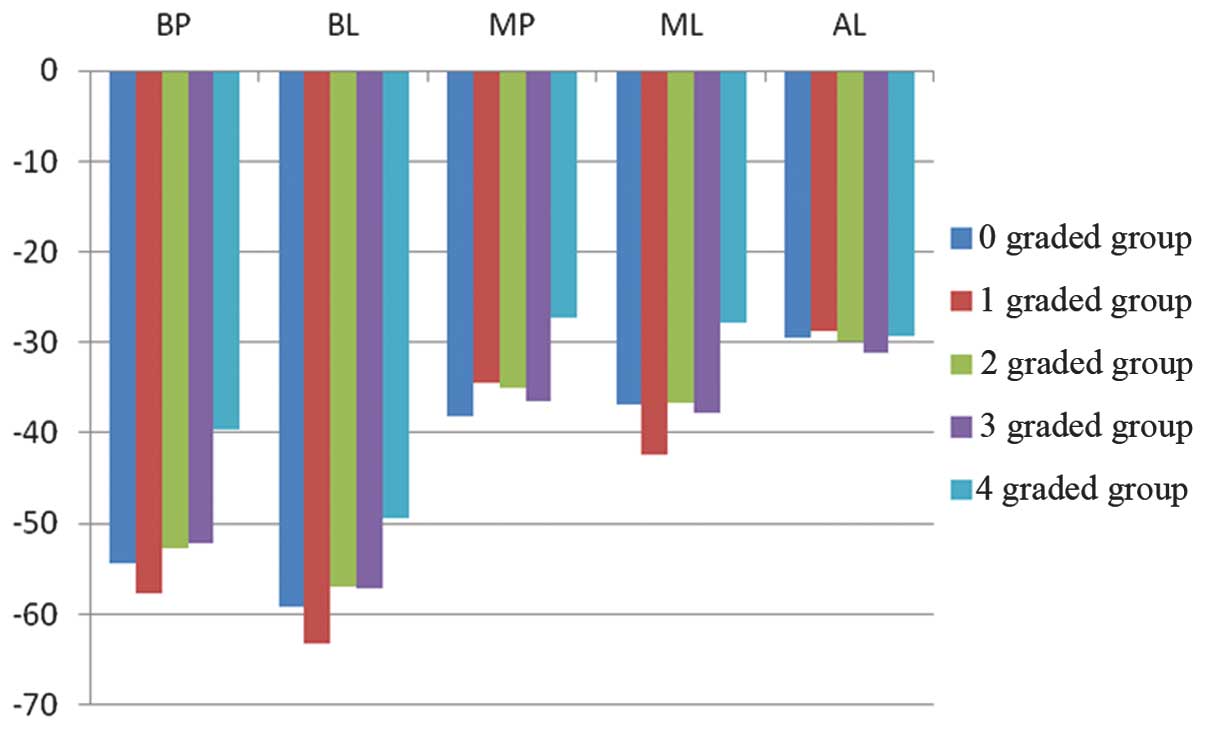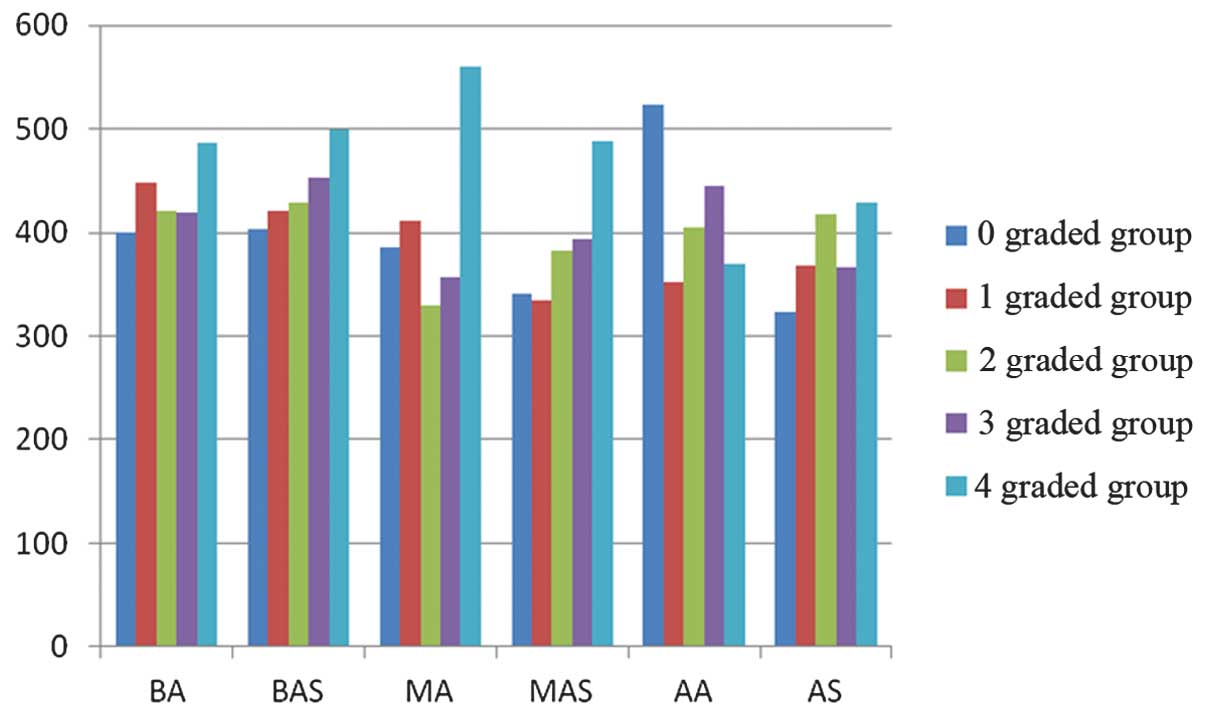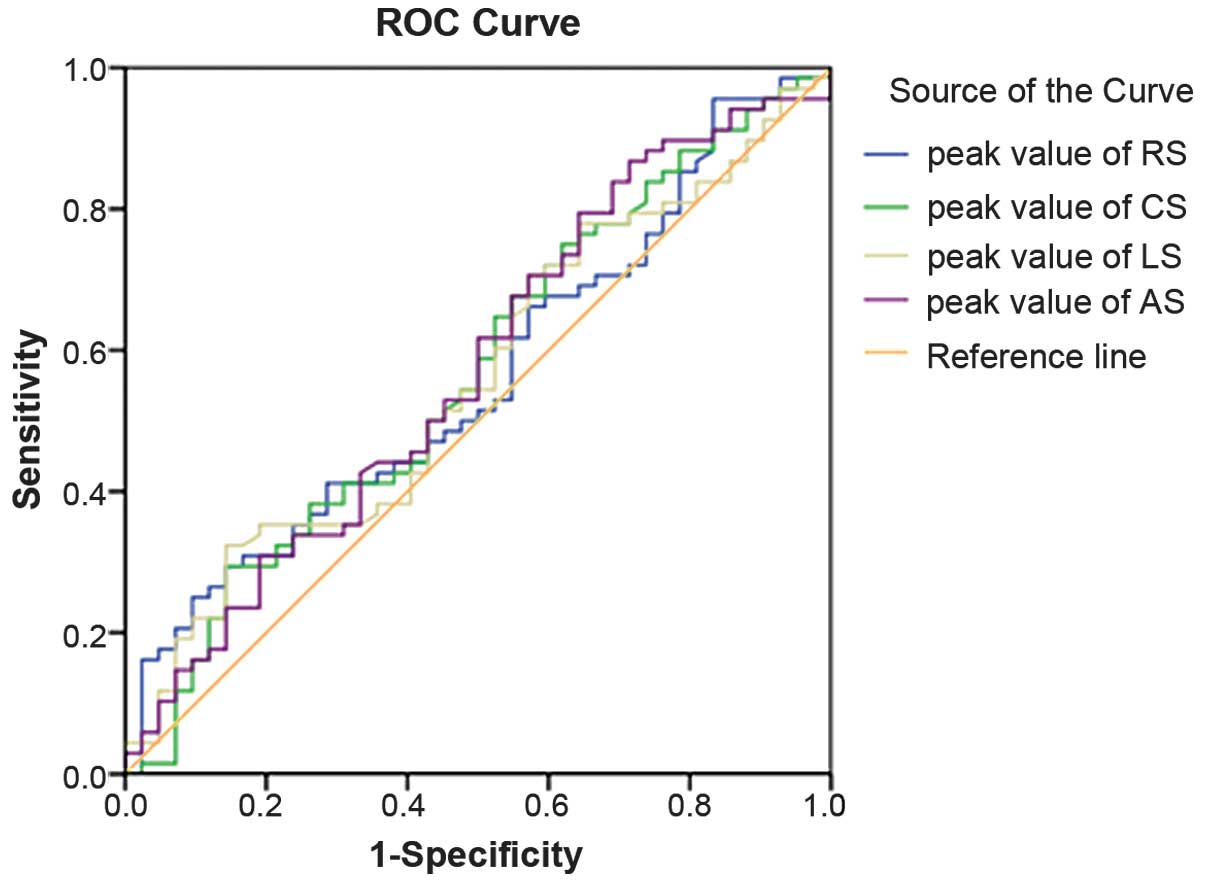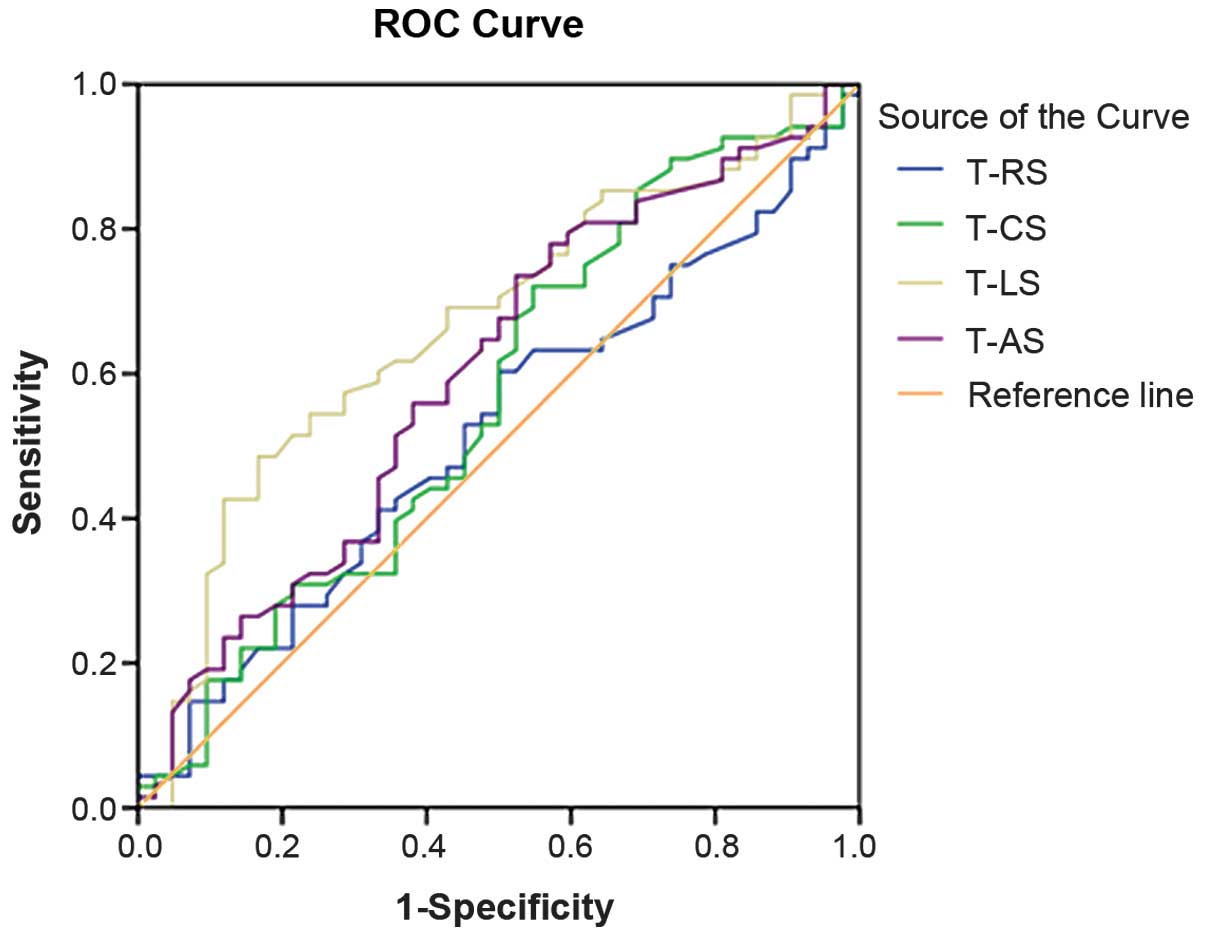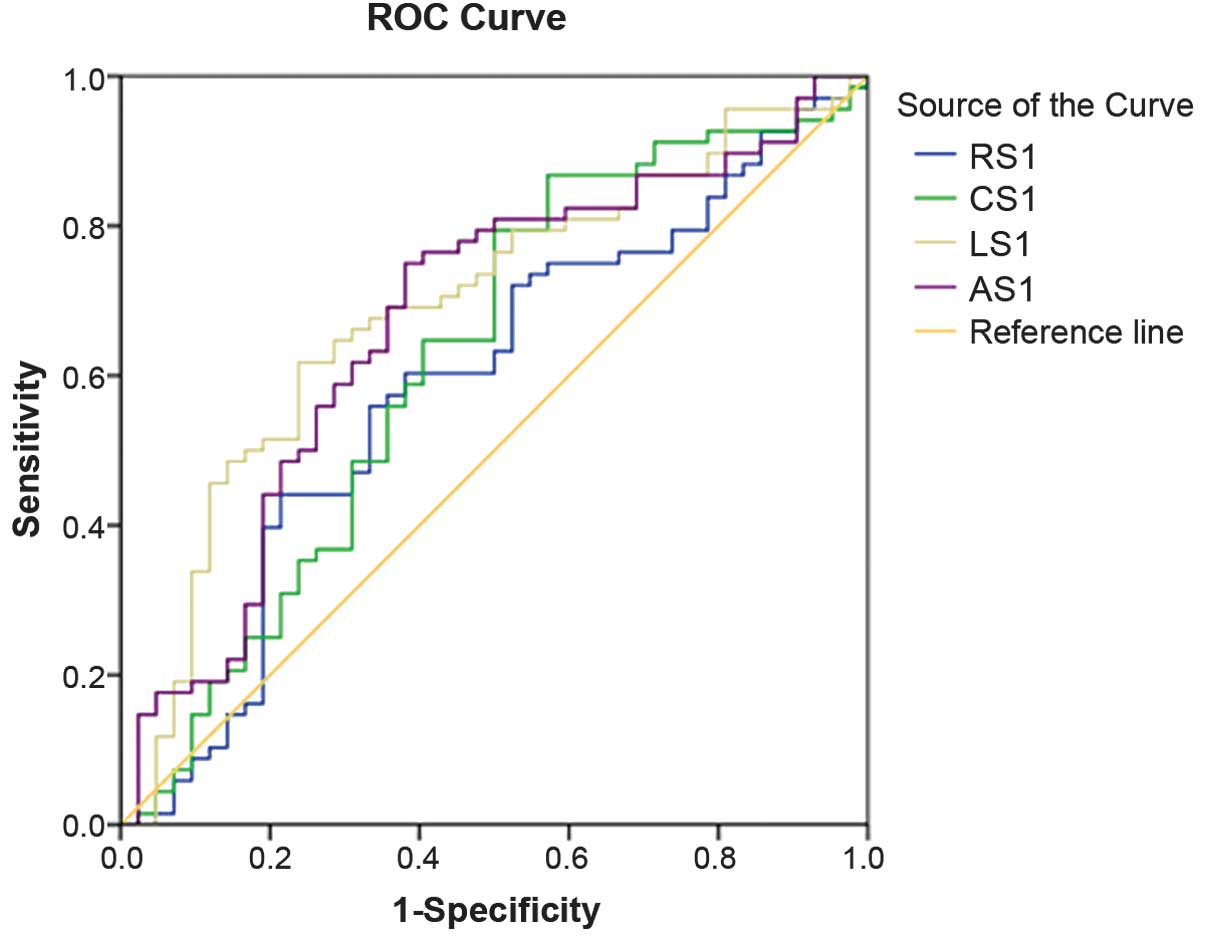Incremental value of resting three-dimensional speckle-tracking echocardiography in detecting coronary artery disease
- Authors:
- Published online on: April 20, 2015 https://doi.org/10.3892/etm.2015.2435
- Pages: 2043-2046
-
Copyright: © Sun et al. This is an open access article distributed under the terms of Creative Commons Attribution License.
Abstract
Introduction
Coronary artery disease (CAD) is the most common cardiovascular disease, and its incidence increases in the elderly (1). Early detection and intervention for left ventricular (LV) dysfunction are of great importance in patients with CAD (2). Echocardiography is noninvasive, inexpensive and convenient. The detection of patients with CAD by this method is likely to improve the benefit-risk ratio in patients.
During recent years, strain and strain rate imaging echocardiography have emerged as valuable tools that provide a comprehensive and reliable assessment of myocardial function (3–5). Studies have suggested that two-dimensional speckle-tracking echocardiography (2D-STE) can be used to assess LV systolic dysfunction (6,7). However, 2D-STE has intrinsic limitations, such as long examination times, a geometric assumption of LV morphology, and mistracking if speckles move out of the scanning plane (8,9).
However, three-dimensional speckle-tracking echocardiography (3D-STE) is free of geometric assumptions and speckles moving out of the scanning plane. In addition, 3D-STE is less time-consuming than conventional 2D-STE (10,11). It provides an accurate and convenient assessment of LV function (12) and has been shown to be useful in the detection of subclinical LV dysfunction in patients with early-stage heart failure (13) and hypertension (14). In the present study, the aim was to investigate the incremental value of resting 3D-STE in the detection of LV dysfunction in patients with CAD and to identify sensitive indicators for the detection of CAD.
Patients and methods
Study population
The study evaluated 110 patients (68 males; age, 63±9 years) who were suspected of having CAD and who were referred for coronary artery angiography (CAG) at Beijing Hospital (Beijing, China) between June 2010 and August 2012. The mean height of the patients was 166.4±7.8 cm and the body weight was 72.7±10.2 kg. The exclusion criteria were arrhythmia, a history of myocardial infarction and percutaneous coronary intervention (PCI), heart failure, cardiomyopathy, valvular heart diseases, congenital heart disease and poor 3D image quality. The present study was approved by the Ethics Committees of Beijing Hospital of the Ministry of Health (Beijing, China). All of the patients in the study signed an informed consent form.
Echocardiographic image acquisition and analyses
Echocardiographic data were acquired with a Artida SSH-880A ultrasound system (Toshiba, Nasu, Japan), which was equipped with a 2D transducer (frequency, 1–5 MHz), 3D volume transducer, 3D speckle-tracking analysis software and a background processing workstation. Firstly, general 2D ultrasonic detectors were used to collect images of the parasternal long axis, short axis and apical four-chamber view. During the inspection, all patients were connected to timing ECG, and maintained in the left lateral decubitus position. Secondly, following conversion to the 3D volume transducer with an apical four-chamber view, the pre-4D mode was selected to obtain a clear image of the LV endocardium. Then, as the full-4D mode was entered, the patient was asked to hold their breath at the end of expiration. The imaging angle was maintained at (70–80°)×(70–80°) and cardiac 3-D images in the form of full-4D dynamic images were collected and stored.
The stored dynamic cardiac images were extracted in the off-line state. This involved entering ‘3DT (three-dimensional speckle tracking) mode’, adjusting the baseline and angle, clearly displaying the image of the endocardium, mitral annulus and apex, and speckle assignment on plane A and plane B separately. The instrument then speckle-tracked automatically when the ‘start’ button was pressed. The curve of the endocardium was drawn (in chart 1), and the software analyzed the data and calculated the peak value strains [longitudinal strain (LS), circumferential strain (CS), radial strain (RS) and area strain (AS) of 16 sections of the left ventricle and the time to peak value of the strains.
Observational indices
Strain values and the time to peak value of the strain for 16 local myocardial segments from the 3D-STI were observed. The strain values were RS, CS, LS and AS. The time to peak values for the strains were time to peak radial strain (T-RS), time to peak circumferential strain (T-CS), time to peak longitudinal strain (T-LS) and time to peak area strain (T-AS).
Statistical analysis
The observation indices were numerical variable data. After establishing the database, with the use of Excel (Microsoft Corporation, Redmond, WA, USA) and SPSS version 16.0 (SPSS, Inc., Chicago, IL, USA), binary logistic regression analysis and receiver operator characteristic curves (ROCs) were used to analyze the sensitivity of the strains for the diagnosis of the CAD. P<0.05 was considered to indicate a statistically significant difference.
Results
Results of CAG
According to the CAG results, of the 110 patients enrolled, 68 exhibited CAD (levels 1–4), which were assigned to the CAD group. The other patients (level 0) were designated the non-CAD group (Table I).
3D-STI evaluation of LV local function in different graded stenoses of coronary arteries
Generally, it was observed that the peak value of strain of local segments of the left ventricle decreased as the stenosis degree of the supplied vessel increased, that is, the higher the degree of stenosis the lower the peak value. When considering the time to the peak value of strain, the inverse relationship was observed, that is, the higher the degree of stenosis the longer the time to the peak value. In addition, these relationships were most evident at the highest graded degree of stenosis.
For example, the peak value of AS of certain segments supplied by the left circumflex (LCX) artery exhibited a reduction in differently graded coronary stenosis groups. The higher the grade of stenosis the lower the peak value of AS (Fig. 1). In addition, the T-LS of certain segments supplied by the left anterior descending artery ascended in differently graded coronary stenosis groups (Fig. 2).
ROC curve and sensitive indicators
ROC curves were used to analyze the peak value and the time to peak value of the strains that were measured by 3D-STE, in order to investigate whether 3D-STE has value for the early detection of CAD and to identify sensitive indicators.
In this study, three kinds of ROC were generated. One was for the peak strains RS, CS, LS and AS (Fig. 3), one was for the time to the peak strain, which comprised T-RS, T-CS, T-LS and T-AS (Fig. 4), and the third was for the composite index. The composite indices were designated RS1, CS1, LS1 and AS1 (Fig. 5), which were combinations of the peak strain value and time to peak of the RS, CS, LS and AS, respectively. Through the ROC analysis, an area under the curve (AUC) was determined for each index.
Analysis of the ROC curves and AUCs, revealed that each individual peak value of strain, namely RS, CS, LS and AS, had no diagnostic value for the early detection of CAD (P>0.05). Only T-LS had statistical significance in the diagnosis of CAD (P=0.003, AUC=0.667). However, the composite index of peak strain and time to peak strain had significantly higher sensitivity for the detection of CAD. The AUC of CS1 was 0.621 (P=0.034), of LS1 was 0.692 (P=0.001) and of AS1 was 0.672 (P=0.003). This suggests that resting 3D-STE had value for the early detection of CAD, and the sensitive indicators were T-LS, CS1, LS1 and AS1. In addition, the AUC decreases in the order LS1 > AS1 > T-LS > CS1 (Table II), which means that LS1 has the highest diagnostic value for CAD.
In summary, it may be concluded that the T-LS and the composite indices that combine peak value and time to peak of the longitudinal, circumferential and area strains have diagnostic value for CAD. The AUCs are 0.667, 0.692, 0.621 and 0.672, respectively (P<0.005). LS1 had the best diagnostic value for the CAD and was found to have 62% sensitivity and 76% specificity for the detection of CAD. However, the peak values of LS, C-S, RS and AS and the T-CS, T-RS and T-AS were not identified to be of diagnostic value for CAD.
Excellent diagnostic value and individual prediction
Through the analysis of the ROC of LS1, it was determined that the maximum Youden index was 0.38 and the excellent diagnostic probability value (Pexce) of the LS1 was Pexce=0.615. Pexce is an ROC-derived statistical index that indicates the likelihood of a positive diagnosis. In the excellent diagnostic value, the sensitivity and the specificity were 61.8% and 76.2% respectively.
For individual prediction, the individual prediction probability (Pindi) may be determined and compared with the Pexce. Pindi is a probability value that can be used to predict whether the individual patient is likely to have the disease or not, and can be compared with Pexce. When the Pindi is greater, a positive individual judgment can be made, which is that the patient can be diagnosed with CHD. For calculating Pindi of LS1, this study established a binary logistic regression equation through logistic regression analysis, as follows: Pindi=1/[1+e− (−1.513+0.1×(LS-peak value)+0.009×(LS-time to peak value))]. Therefore, when the 3D-STE for the patient was completed, the peak value and the time to peak value of LS were obtained by the analysis software, and Pindi was calculated. Finally, through the comparison of Pindi with Pexce, an early decision of whether the patient has CHD or not could be made.
Discussion
Speckle-tracking strain imaging has been demonstrated to be an appropriate method for the examination of global and regional LV functional properties (15,16), which was confirmed in the present study. In this study, it was found that changes in the peak value and time to peak value of certain strains accorded with the physiological characteristics of the left ventricle.
Secondly, through the ROC analysis of each parameter measured by 3D-STE, certain sensitive indicators for the detection of CAD by 3D-STE were identified. These were T-LS and the composite indices LS1, AS1 and CS1. Among them, LS1 had the highest diagnostic value for CAD, with an AUC of 0.692. With regard to excellent diagnostic value, the sensitivity and specificity were 61.8 and 76.2%, respectively.
By convention, myocardial deformation is divided into three directions (17). LS and CS are considered to reflect the contraction of longitudinally arranged endocardial fibers and circumferentially arranged midlayer fibers, respectively. In general, the longitudinally arranged subendocardial fibers are more vulnerable due to their direct exposure to the intraventricular blood pressure and the anatomy of the coronary circulation (18,19). As a result, longitudinal function is impaired first in many diseases, including CAD.
Severe CAD is known to lead to LV dysfunction. However, the LV ejection fraction is usually normal at a relatively early stage, particularly at the rest status (20). Thus, establishing a more sensitive index for early-stage LV dysfunction is of great importance. In the present study, it was demonstrated that resting 3D-STE had incremental value for the prompt detection of coronary lesions and a logistic regression equation was established. Therefore, in the clinic, if the peak value and the time to peak value of LS are obtained through 3D-STE, it should be possible to make a preliminary judgment as to whether the patient has CHD or not. This provides more information when making decisions about CAG surgery.
In the present study, it was confirmed that the resting 3D-STE had certain incremental value in the detection of CAD, but the sensitivity and specificity were not high enough. Future studies of stress echocardiography are planned, which aim to improve the sensitivity. In addition, an evaluation model may be established through the addition of risk factors such as hypertension, diabetes, smoking and hyperlipidemia.
In conclusion, 3D-STE has incremental value for the diagnosis of CAD in patients at rest. LS1 has the highest sensitivity of 61.8% for the early detection of CAD. 3D-STE has the potential to improve the value of echocardiography in the detection of the CAD and to provide more information for clinical physicians.
References
|
Dobesh PP, Beavers CJ, Herring HR, et al: Key articles and guidelines in the management of acute coronary syndrome and in percutaneous coronary intervention: 2012 update. Pharmacotherapy. 32:e348–e386. 2012. View Article : Google Scholar : PubMed/NCBI | |
|
Gaemperli O: Role of noninvasive imaging in cardiology. Praxis (Bern 1994). 102:29–37. 2013.(In German). View Article : Google Scholar : PubMed/NCBI | |
|
Health Quality Ontario: Stress echocardiography for the diagnosis of coronary artery disease: an evidence-based analysis. Ont Health Technol Assess Ser. 10:1–61. 2010. | |
|
Hoit BD: Strain and strain rate echocardiography and coronary artery disease. Circ Cardiovasc Imaging. 4:179–190. 2011. View Article : Google Scholar : PubMed/NCBI | |
|
Dandel M and Hetzer R: Echocardiographic strain and strain rate imaging - clinical applications. Int J Cardiol. 132:11–24. 2009. View Article : Google Scholar : PubMed/NCBI | |
|
Shimoni S, Gendelman G, Ayzenberg O, et al: Differential effects of coronary artery stenosis on myocardial function: the value of myocardial strain analysis for the detection of coronary artery disease. J Am Soc Echocardiogr. 24:748–757. 2011. View Article : Google Scholar : PubMed/NCBI | |
|
Kouzu H, Yuda S, Muranaka A, et al: Left ventricular hypertrophy causes different changes in longitudinal, radial, and circumferential mechanics in patients with hypertension: a two-dimensional speckle tracking study. J Am Soc Echocardiogr. 24:192–199. 2011. View Article : Google Scholar : PubMed/NCBI | |
|
Saito K, Okura H, Watanabe N, et al: Comprehensive evaluation of left ventricular strain using speckle tracking echocardiography in normal adults: comparison of three-dimensional and two-dimensional approaches. J Am Soc Echocardiogr. 22:1025–1030. 2009. View Article : Google Scholar : PubMed/NCBI | |
|
Biswas M, Sudhakar S, Nanda NC, et al: Two- and three-dimensional speckle tracking echocardiography: clinical applications and future directions. Echocardiography. 30:88–105. 2013. View Article : Google Scholar : PubMed/NCBI | |
|
Urbano-Moral JA, Patel AR, Maron MS, et al: Three-dimensional speckle-tracking echocardiography: methodological aspects and clinical potential. Echocardiography. 29:997–1010. 2012. View Article : Google Scholar : PubMed/NCBI | |
|
Altman M, Bergerot C, Aussoleil A, et al: Assessment of left ventricular systolic function by deformation imaging derived from speckle tracking: a comparison between 2D and 3D echo modalities. Eur Heart J Cardiovasc Imaging. 15:316–323. 2014. View Article : Google Scholar : PubMed/NCBI | |
|
Thorstensen A, Dalen H, Hala P, et al: Three-dimensional echocardiography in the evaluation of global and regional function in patients with recent myocardial infarction: A comparison with magnetic resonance imaging. Echocardiography. 30:682–692. 2013. View Article : Google Scholar : PubMed/NCBI | |
|
Li CM, Li C, Bai WJ, et al: Value of three-dimensional speckle-tracking in detecting left ventricular dysfunction in patients with aortic valvular diseases. J Am Soc Echocardiogr. 26:1245–1252. 2013. View Article : Google Scholar : PubMed/NCBI | |
|
Galderisi M, Esposito R, Schiano-Lomoriello V, et al: Correlates of global area strain in native hypertensive patients: A three-dimensional speckle-tracking echocardiography study. Eur Heart J Cardiovasc Imaging. 13:730–738. 2012. View Article : Google Scholar : PubMed/NCBI | |
|
Seo Y, Ishizu T, Enomoto Y, et al: Validation of 3-dimensional speckle tracking imaging to quantify regional myocardial deformation. Circ Cardiovasc Imaging. 2:451–459. 2009. View Article : Google Scholar : PubMed/NCBI | |
|
Luis SA, Yamada A, Khandheria BK, et al: Use of three-dimensional speckle-tracking echocardiography for quantitative assessment of global left ventricular function: a comparative study to three-dimensional echocardiography. J Am Soc Echocardiogr. 27:285–291. 2014. View Article : Google Scholar : PubMed/NCBI | |
|
Urbano-Moral JA, Arias-Godinez JA, Ahmad R, et al: Evaluation of myocardial mechanics with three-dimensional speckle tracking echocardiography in heart transplant recipients: comparison with two-dimensional speckle tracking and relationship with clinical variables. Eur Heart J Cardiovasc Imaging. 14:1167–1173. 2013. View Article : Google Scholar : PubMed/NCBI | |
|
Tsai WC, Liu YW, Huang YY, et al: Diagnostic value of segmental longitudinal strain by automated function imaging in coronary artery disease without left ventricular dysfunction. J Am Soc Echocardiogr. 23:1183–1189. 2010. View Article : Google Scholar : PubMed/NCBI | |
|
Jasaityte R, Heyde B and Dhooge J: Current state of three-dimensional myocardial strain estimation using echocardiography. J Am Soc Echocardiogr. 26:15–28. 2013. View Article : Google Scholar : PubMed/NCBI | |
|
Parato VM, Mehta A, Delfino D, et al: Resting echocardiography for the early detection of acute coronary syndromes in chest pain unit patients. Echocardiography. 27:597–602. 2010. View Article : Google Scholar : PubMed/NCBI |



